How-To Guides
Microwave Maintenance Tips: How to Do It at Home
AZparts Team
Updated on July 31, 2025
9 min read
Your microwave works hard every day, heating meals and warming beverages countless times. Like any frequently used appliance, it needs regular maintenance to stay efficient and safe. Proper microwave maintenance extends your device's lifespan while ensuring optimal performance and food safety. At AZParts, we've created this comprehensive guide to help you maintain your microwave effectively at home, saving money on repairs and keeping your appliance running smoothly.

1. What You’ll Need to Maintain Microwave
Before starting the maintenance process, it's essential to gather the right tools and materials for safe and effective cleaning. Having everything prepared beforehand will make the maintenance process smoother and more efficient. Most items you'll need are common household products already available in your kitchen or cleaning supply cabinet.
Essential Cleaning Supplies:
- White vinegar: Acts as a natural deodorizer and helps break down grease and grime effectively. Its acidic properties make it perfect for dissolving mineral deposits and neutralizing odors without harsh chemicals.
- Baking soda: Serves as a gentle abrasive and powerful odor neutralizer. It's safe for all microwave surfaces and won't scratch delicate interior coatings like commercial cleaners might.
- Mild dish soap: Essential for general cleaning purposes and removing grease buildup. Choose a gentle formula that won't leave residue or create excessive suds during cleaning.
- Clean microfiber cloths or soft sponges: These materials effectively capture dirt and debris without scratching surfaces. Microfiber is particularly effective at trapping particles and can be used damp or dry.
- Spray bottle: Allows for even application of cleaning solutions and better control over moisture levels. This prevents oversaturation that could damage electrical components.
- Microwave-safe bowl: Necessary for steam cleaning methods that help loosen stubborn stains and neutralize odors naturally without harsh scrubbing.
Safety and Additional Tools:
- Rubber gloves: Protect your hands from cleaning chemicals and potential sharp edges inside the microwave. They also provide better grip when handling wet or slippery components.
- Soft-bristled brush or old toothbrush: Perfect for reaching tight spaces and removing stubborn debris from vents and crevices without damaging delicate components.
- Paper towels: Handy for quick cleanups, drying surfaces, and handling any unexpected spills during the maintenance process.
- Larger cleaning area: Having access to your kitchen sink provides space for thoroughly cleaning removable parts like turntables and roller rings.
Quality replacement parts should be readily available when components show signs of wear or damage. Having the right tools and materials at your disposal sets the foundation for thorough and effective microwave maintenance that will keep your appliance running smoothly for years to come.
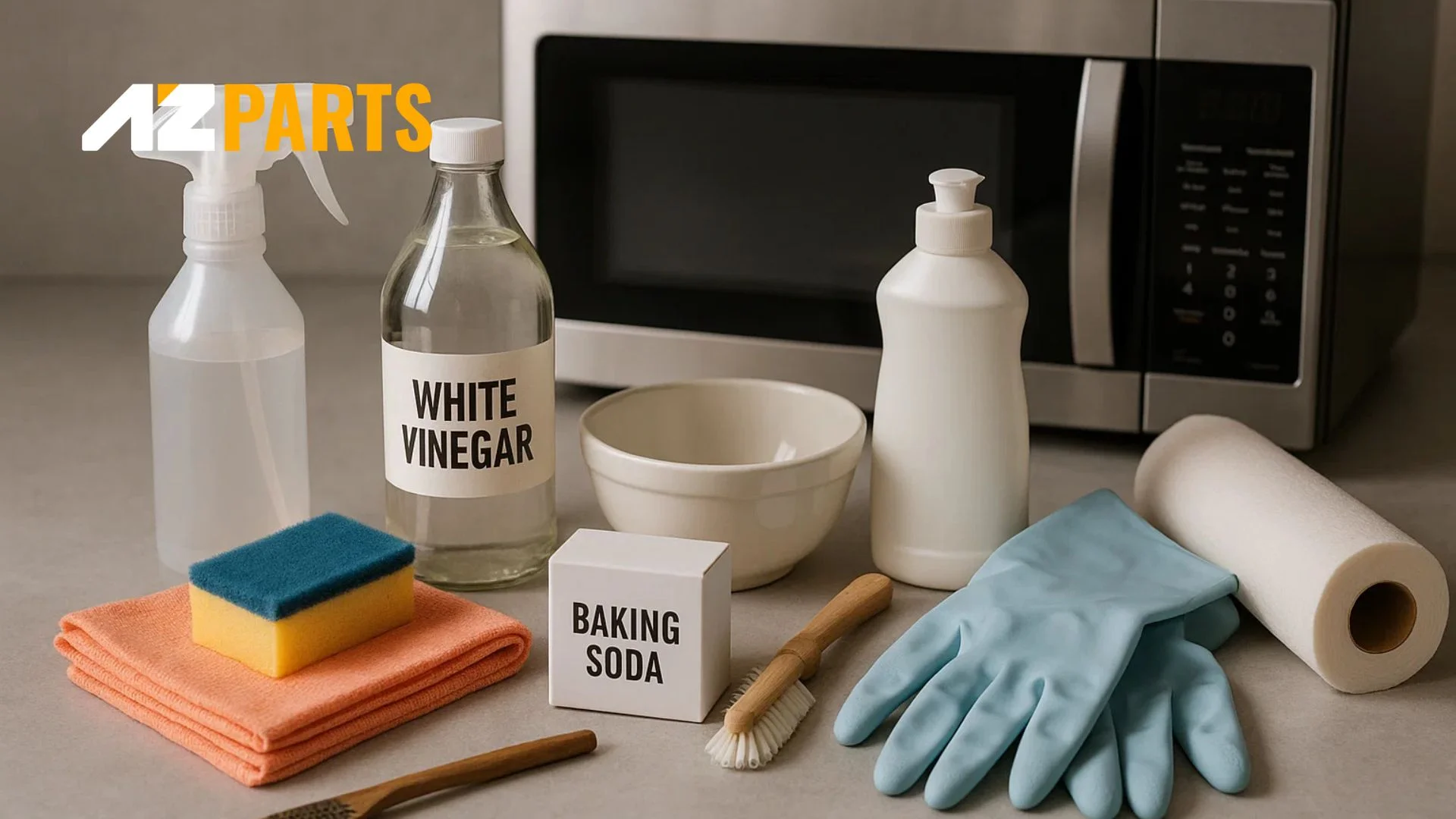
Prepare tools and materials (Source: AZParts)
2. Microwave Maintenance Step-by-Step
Following a systematic approach ensures no area is overlooked and each component receives the proper attention it deserves. This proven process has been developed based on manufacturer recommendations and works effectively across various microwave models and brands.
2.1. Clean the Inside of the Microwave
The interior collects food splatters, grease, and odors that affect performance and food taste. Start by ensuring the microwave is cool and unplugged for safety.
Steam Cleaning Method:
Mix equal parts water and white vinegar in a microwave-safe bowl, add a few drops of lemon juice, then heat on high for 2-3 minutes. Leave the bowl inside for 5 additional minutes with the door closed. Remove carefully with oven mitts.
Cleaning Process:
Wipe all interior surfaces with a damp cloth, focusing on ceiling, walls, and floor where splatters accumulate. For stubborn stains, make a baking soda paste, apply to problem areas, and let sit before scrubbing gently. Clean the waveguide cover (small protective panel) very gently with a barely damp cloth. Never use abrasive cleaners or harsh chemicals.
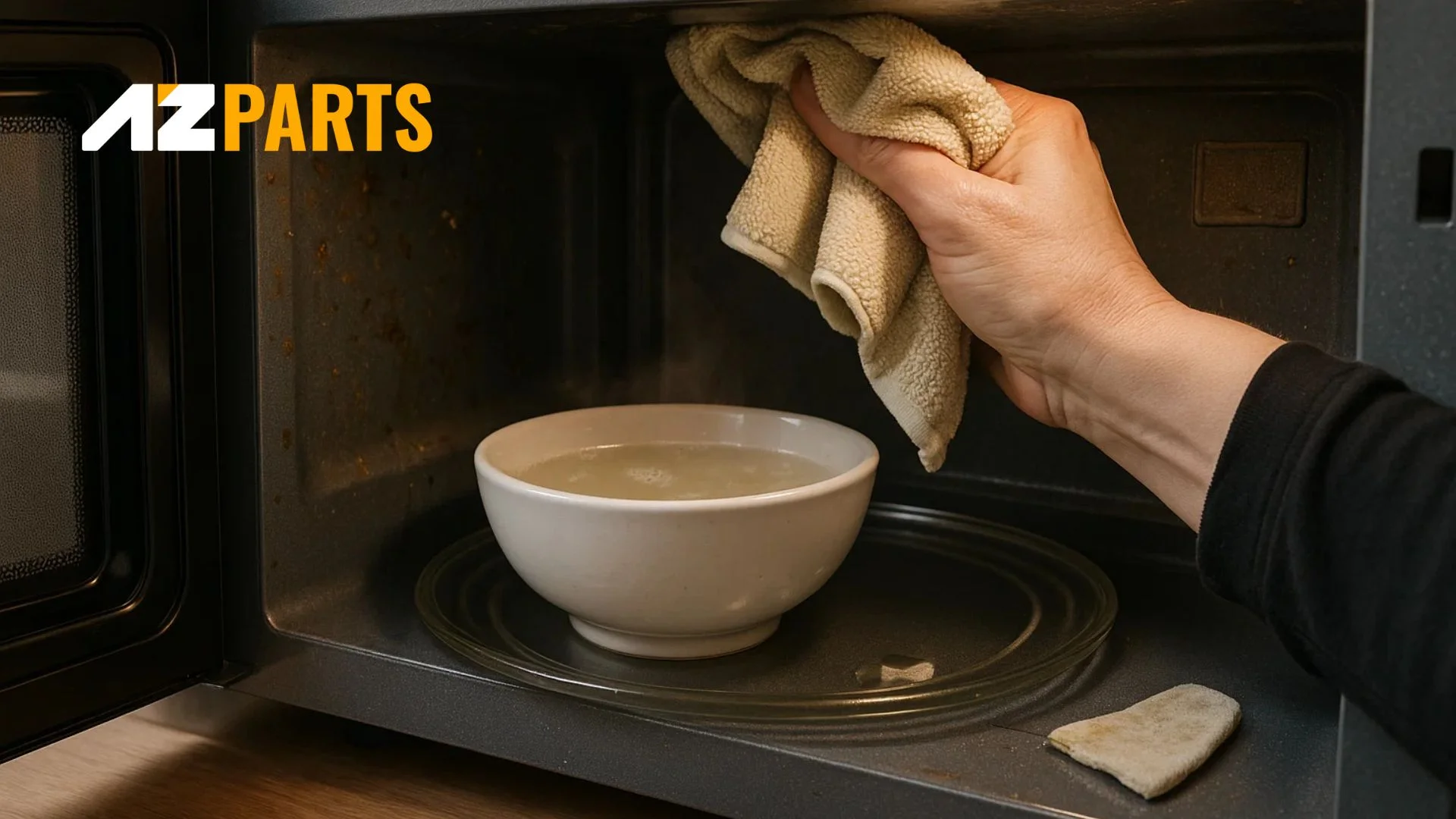
Clean the inside of the microwave (Source: AZParts)
2.2. Clean the Microwave Turntable
The glass turntable rotates constantly while collecting spills. Regular cleaning prevents bacteria and ensures even heating.
Lift the turntable out carefully, noting its position for reinstallation. Check for cracks or chips - even tiny damage requires immediate replacement. Rinse under warm water, then wash with soapy water and soft sponge.
For baked-on food, soak in warm water with vinegar for 15-20 minutes. For cloudiness from mineral deposits, use baking soda paste and let sit for 10 minutes before gentle scrubbing. Rinse thoroughly and dry completely before reinstalling.
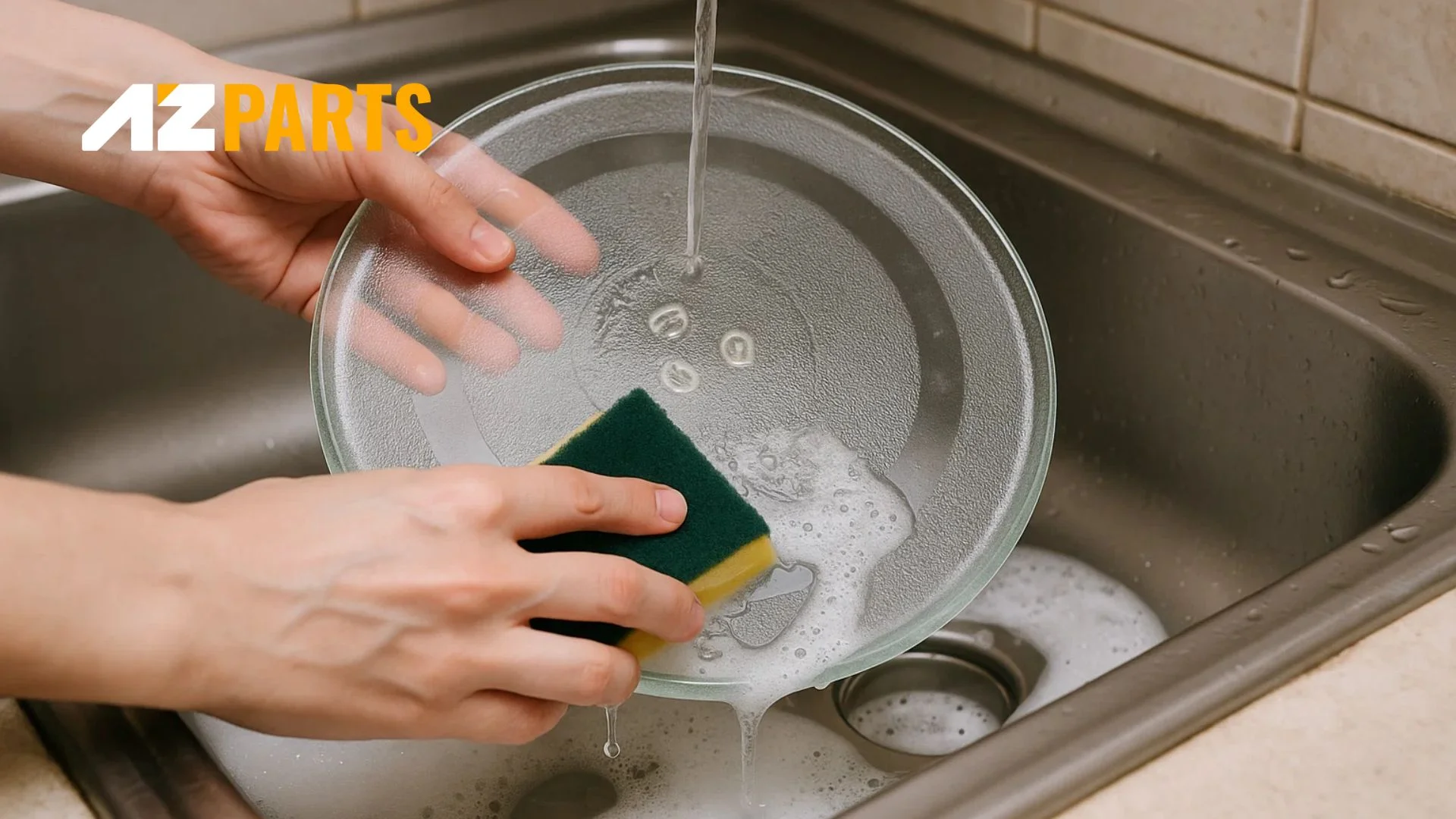
Clean microwave glass turntable (Source: AZParts)
2.3. Clean the Exterior Surface
The exterior faces constant exposure to grease, fingerprints, and splatters. Unplug and let cool completely before cleaning.
Remove dust with a dry microfiber cloth, focusing on buttons, handles, and display areas. For stainless steel, use specialized cleaner or water-vinegar solution applied to cloth (not surface directly), wiping with the grain. Clean painted/plastic surfaces with mild soap and damp cloth.
The control panel harbors bacteria, so clean around buttons carefully with a damp cloth, then use cotton swab with rubbing alcohol for tight spaces. Always apply cleaners to cloths rather than surfaces to prevent moisture damage.
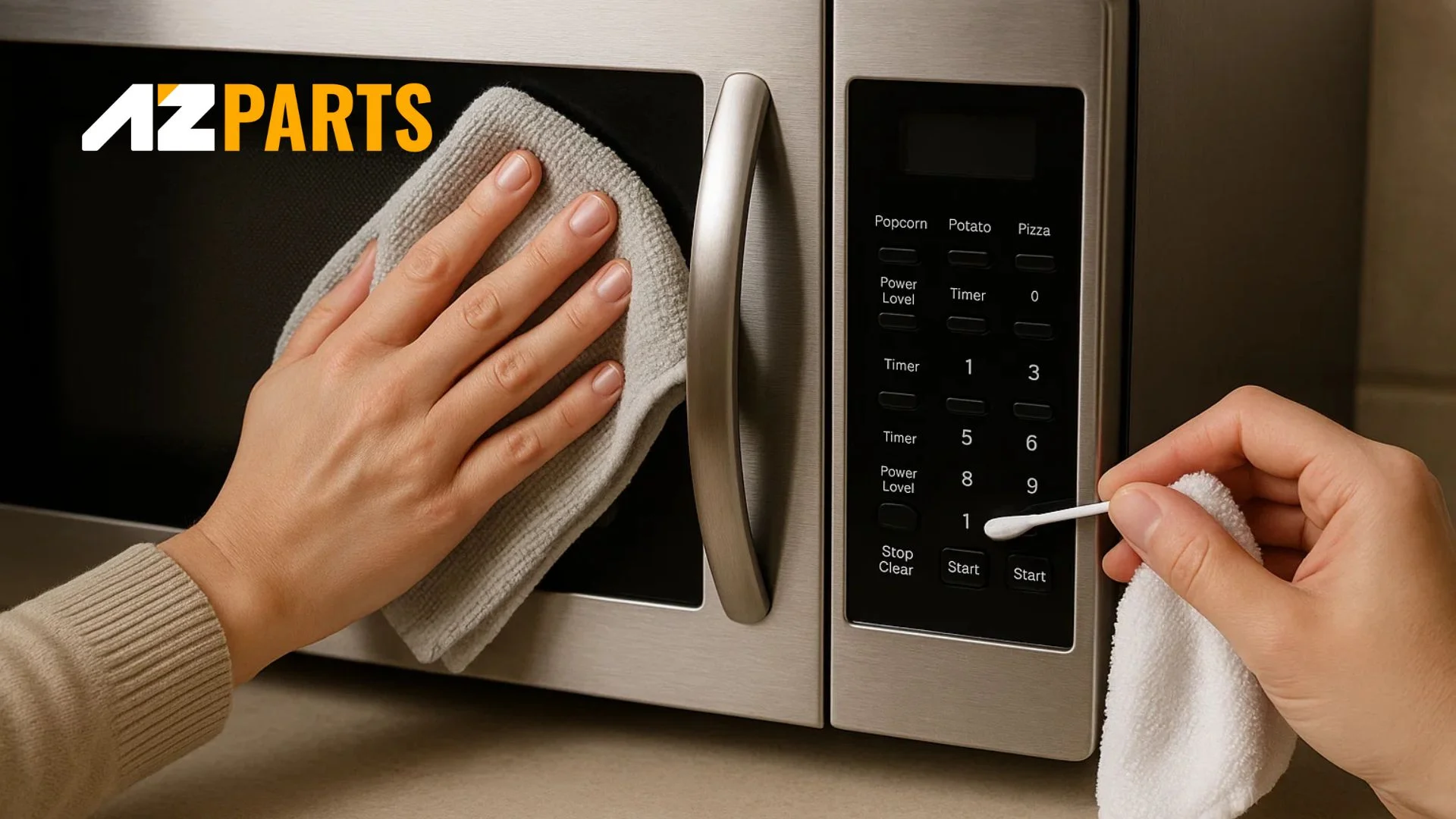
Clean exterior surface thoroughly (Source: AZParts)
2.4. Clean the Vents and Cooling Areas
Proper ventilation prevents overheating and fire hazards. Most microwaves have side, rear, and bottom vents for airflow.
Vacuum loose dust from vent openings with brush attachment. Use soft-bristled brush to scrub grease and grime from vent slats carefully. Apply warm soapy water with a small brush to dissolve buildup, then use compressed air for deep cleaning, directing airflow away from components.
Pay attention to the cooling fan area (back or side) as obstructions cause premature failure. Over-range units have charcoal filters requiring replacement every 6-12 months per manual instructions.
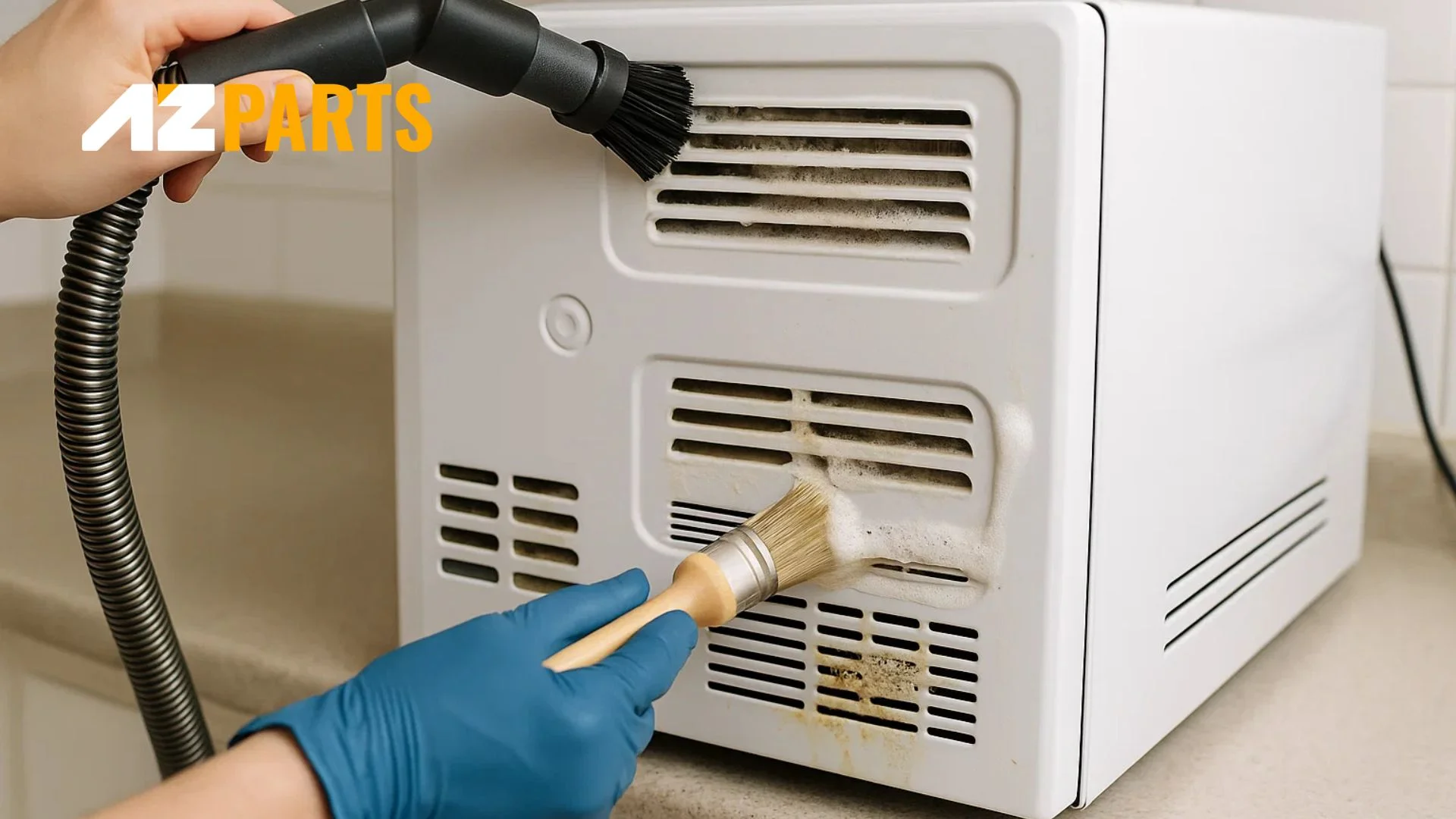
Clean vents and cooling areas (Source: AZParts)
3. Maintain Accessories and Replace When Needed
Microwave accessories play a vital role in the appliance's functionality and your cooking experience, yet they're often overlooked during routine maintenance. These components endure constant use and can develop wear patterns that affect performance, safety, and cooking results over time.
Glass Turntable Maintenance:
- Regular inspection importance: The glass turntable plate is perhaps the most critical accessory, providing the rotating platform that ensures even heating of your food. Even minor damage can compromise safety and performance.
- Damage assessment: Inspect regularly for chips, cracks, or stress fractures, paying particular attention to edges and the bottom surface where stress concentrations typically occur during rotation and loading.
- Safety considerations: Even small cracks can lead to catastrophic failure during use, potentially causing injury from flying glass fragments and damage to your microwave's interior.
- Immediate replacement necessity: Any visible damage, no matter how minor, requires immediate replacement to maintain safe operation and prevent accidents.
If you're looking for a reliable replacement turntable, AZParts has you covered with high-quality microwave glass plates designed to meet OEM specifications and ensure proper fit and safe operation.
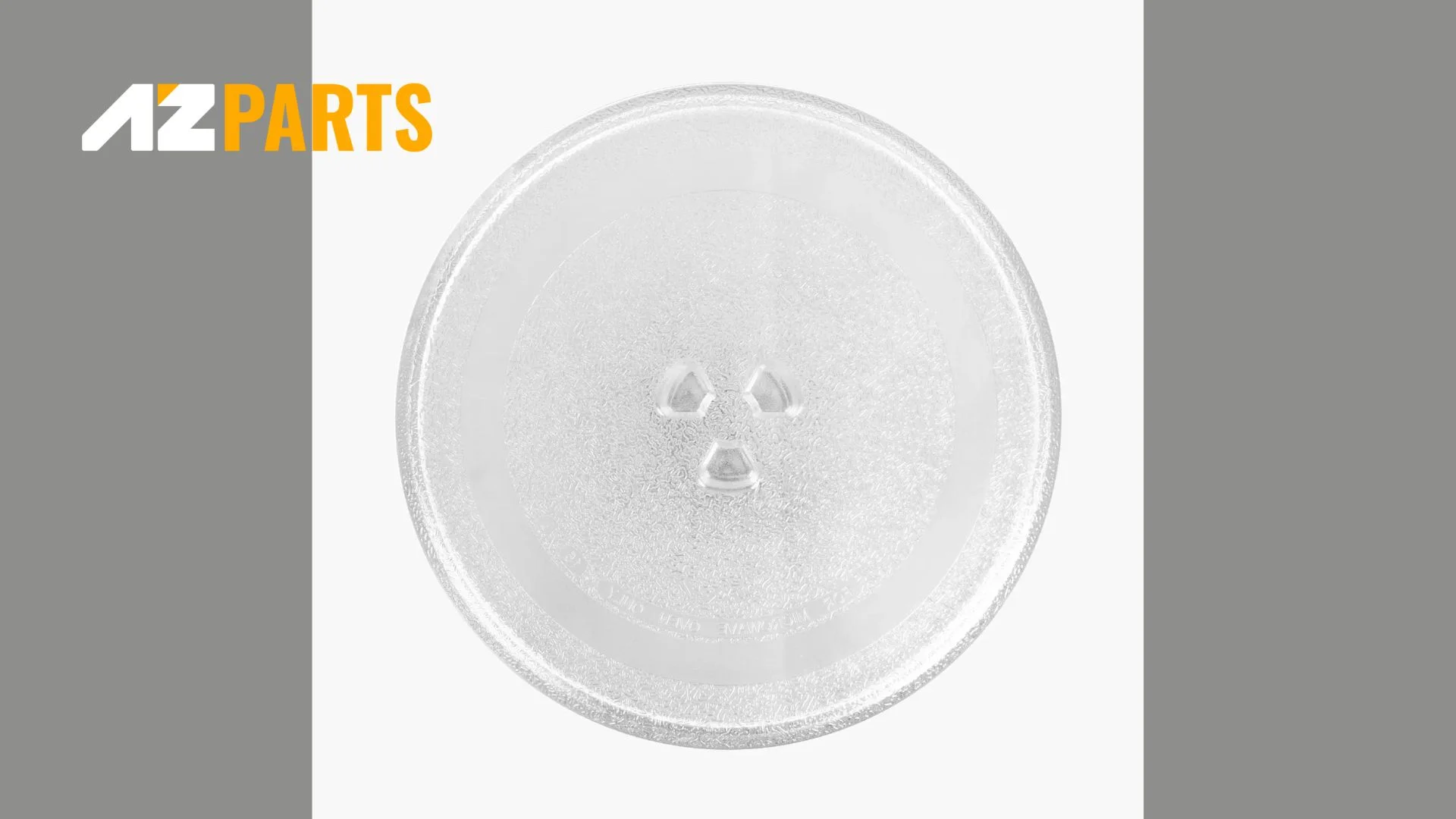
High-quality glass plates part (Source: AZParts)
Microwave Cover Benefits:
- Splatter prevention: Quality microwave covers prevent food splatters from coating interior surfaces, significantly reducing cleaning frequency and maintaining hygiene standards throughout regular use.
- Moisture retention: These protective accessories help retain moisture during heating cycles, improving food quality and preventing overcooking or drying out of heated items, particularly valuable for reheating leftovers.
- Material safety: Covers should be made from microwave-safe materials that won't warp, discolor, or release harmful chemicals under repeated heating cycles, ensuring both durability and food safety.
- Reliable supplier: AZParts provides high-quality microwave covers part designed for durability and safety meeting industry standards for microwave-safe materials and offering consistent performance for both residential and commercial applications.
- Replacement indicators: Replace covers showing signs of warping, cracking, discoloration, or any damage that could affect their protective function to ensure continued effectiveness and prevent potential safety issues.
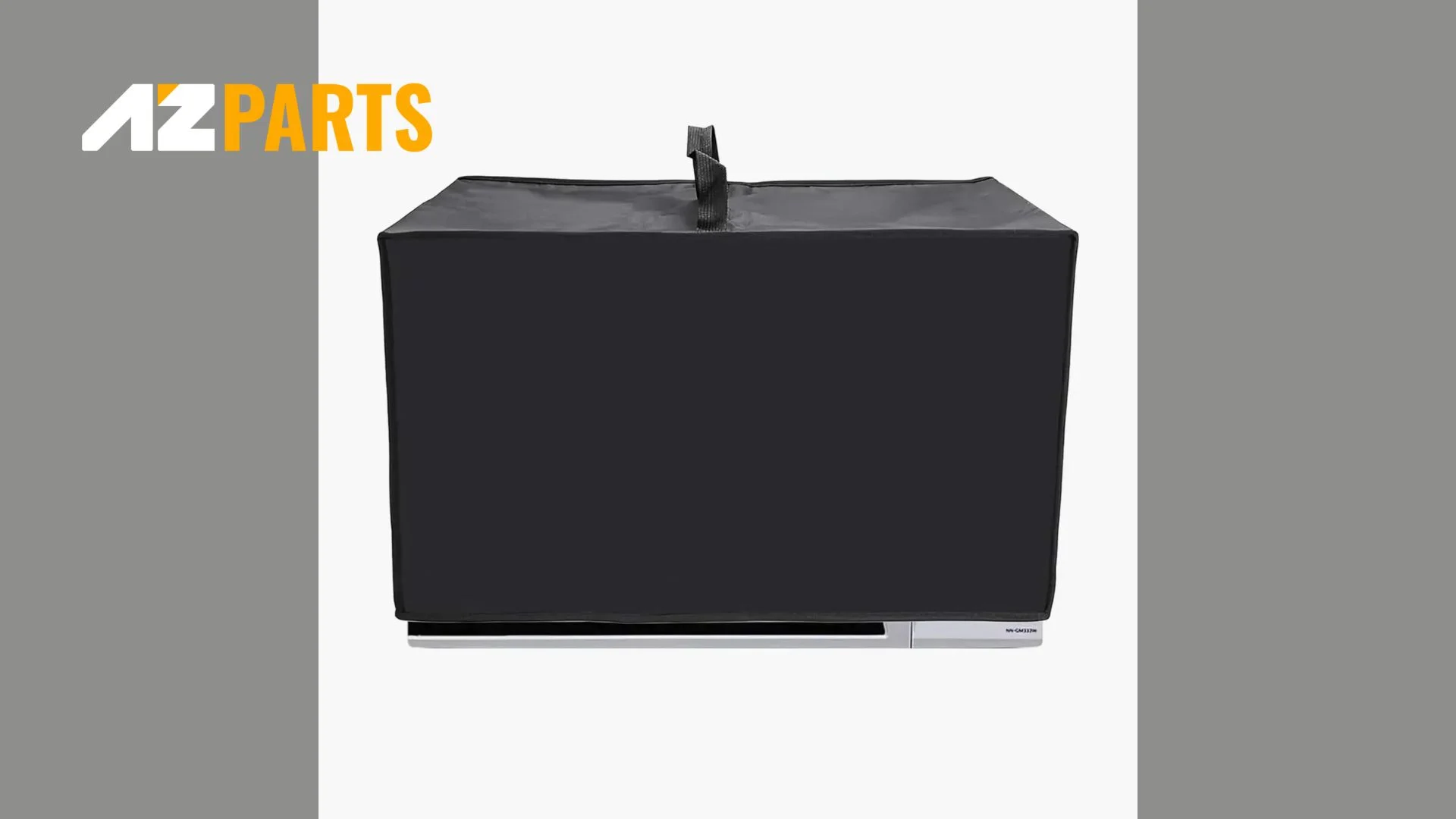
Microwave covers part designed for durability and safety (Source: AZParts)
Door Handle Functionality:
- Safety critical component: Door handles ensure secure closure and proper seal engagement, which is crucial for preventing dangerous microwave energy leakage during operation and maintaining safe kitchen environments.
- Usage wear patterns: These components endure constant daily use and can become loose, cracked, or difficult to operate over time, affecting both functionality and safety standards in your kitchen.
- Reliable replacement source: AZParts supplies high-quality microwave door handles part, offering durable replacements that meet safety standards and ensure proper seal engagement for various microwave models.
- Replacement priority: If your door handle becomes loose, shows cracks, or operates roughly, replacement should be prioritized immediately to maintain safe operation standards and prevent potential safety hazards.
- Professional installation: Some door handle replacements may require professional installation to ensure proper alignment and seal integrity, particularly for models with complex locking mechanisms or specialized mounting systems.
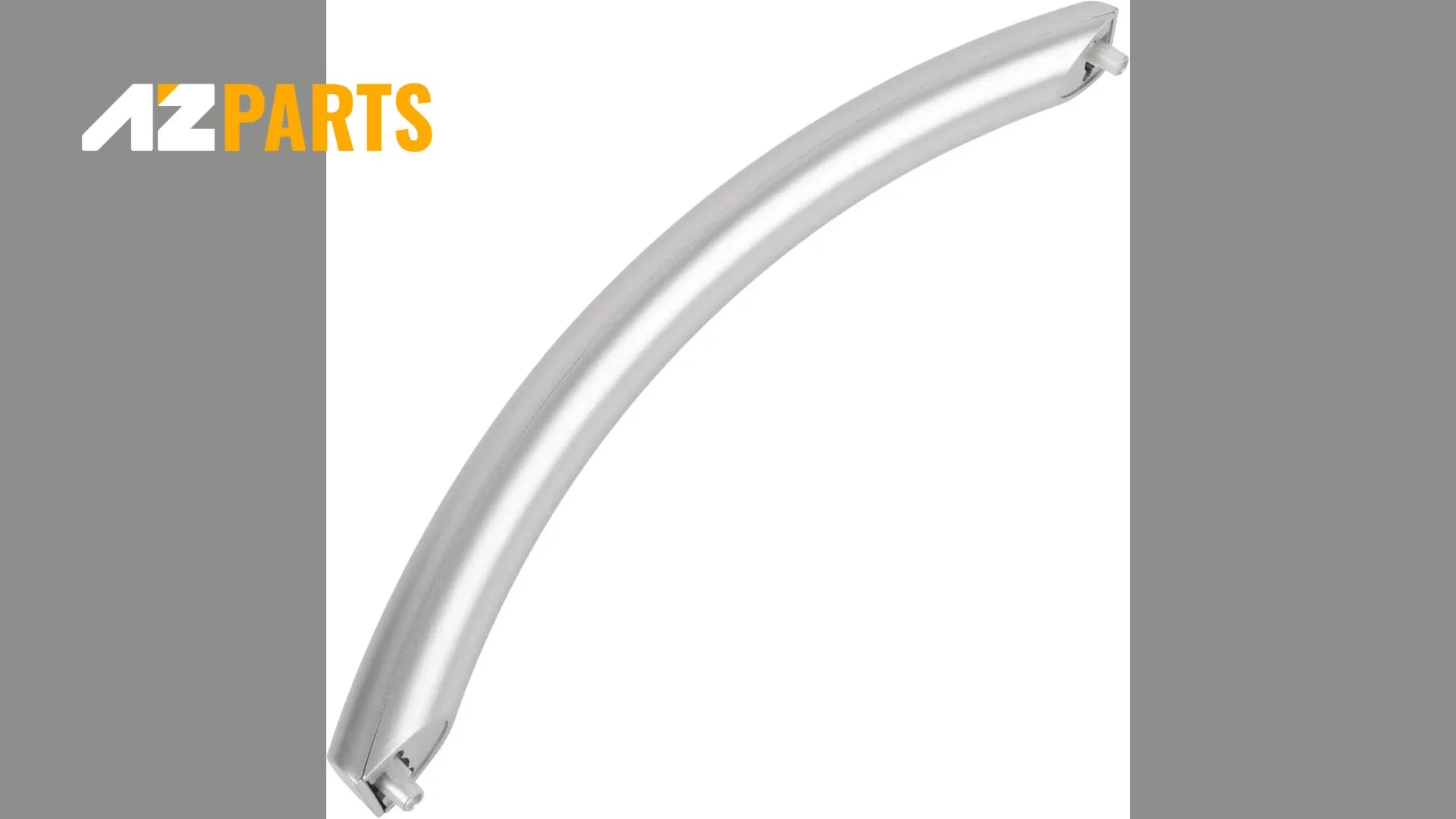
Microwave door handles part (Source: AZParts)
Roller Ring and Support Systems:
- Load-bearing importance: The roller ring or turntable support bears the weight of the rotating plate plus food items, making it subject to significant wear over time.
- Performance indicators: Worn or damaged roller rings can cause the turntable to wobble, stick, make excessive noise, or rotate unevenly during operation.
- Heating impact: These symptoms not only create annoying operational sounds but can also lead to uneven heating patterns and potential strain on the rotation motor.
- Quality replacement: When replacement becomes necessary, choose quality components that match your microwave's specifications for optimal performance and longevity.
4. How Often Should You Perform Microwave Maintenance?
Regular microwave maintenance depends on your usage patterns and cooking habits, but a structured approach ensures optimal performance and longevity.
- Daily care involves wiping the interior with a damp cloth after each use, especially when spills occur. This simple habit prevents stains from setting and reduces the need for intensive cleaning later. Quick attention to high-touch areas like door handles and control buttons maintains hygiene and appearance.
- Weekly maintenance requires thorough interior steam cleaning using the vinegar method to sanitize all surfaces and eliminate odors. Remove and wash the turntable completely, then clean all exterior surfaces including the control panel and door. Households with heavy usage or frequent cooking of greasy foods may need to increase this to twice weekly.
- Monthly deep cleaning focuses on comprehensive vent cleaning and detailed inspection of all removable components for wear or damage. Check that the door seal remains intact, the latch operates smoothly, and the turntable rotates without wobbling. Replace any worn accessories to prevent minor issues from becoming major problems.

Microwave maintenance frequency guidelines (Source: AZParts)
Quarterly assessments should include professional inspection if you notice decreased performance, unusual noises, or irregular heating patterns. Replace charcoal filters in over-range models every 6-12 months depending on usage intensity, and conduct detailed evaluations of internal components not visible during routine cleaning.
Proper microwave maintenance extends appliance life, ensures safety, and maintains reliable performance. Consistent, gentle care proves more effective than sporadic intensive cleaning, preventing minor issues from becoming costly repairs.
Success comes from integrating simple maintenance habits into your kitchen routine. Regular inspection and timely component replacement ensure safe operation while maintaining optimal performance and energy efficiency.
For high-quality replacement parts that meet OEM specifications, visit AZParts today. We provide microwave components needed - from turntables to covers and door handles - to keep your appliance running safely at peak performance.
Contact Info
Address: 8 The Green, Ste A, Dover, Delaware 19901-3618, United States
Email: support@azparts.com
Read more:
Microwave
Further Reading
Further Reading





